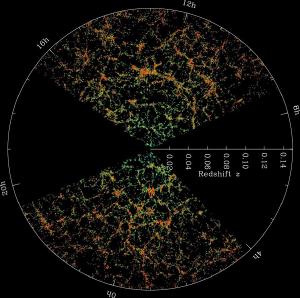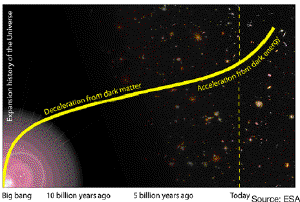Blog
Energy Matters
7 February 2014
Yesterday while doing an AMA on Reddit I was asked an interesting question. How do we know that dark energy, which is the attributed cause of cosmic expansion, isn’t just gravitationally repulsive matter? After all, electric charges can attract and repel, so why not masses? The repelling masses would push against each other and expand the universe. How do we know that isn’t the cause of dark energy? The short answer is that the observational evidence doesn’t support the idea. But it is an interesting demonstration of how you can build and test ideas.
Let’s start with the idea that mass is somehow similar to electric charge. In electromagnetism, there are positive and negative charges, and they follow the rule that charges of the same kind repel each other, while opposite kinds attract. With gravity, masses of the same kind attract each other, so we could suppose that there is positive and negative mass, where masses of the same kind attract each other and opposites repel.
With charge, opposite kinds tend to come together to form objects that are electrically neutral. The atoms in our body, for example, have positive and negative charges, but they tend to be distributed pretty evenly. For our hypothetical positive and negative mass, you would tend to get clumps of one kind or another. So we might speculate that some galaxies are formed of positive matter, while others are formed of negative matter.
 Sloan Digital Sky Survey
Sloan Digital Sky SurveyThat’s an interesting idea, but if that were the case, positive mass galaxies would attract other positive mass galaxies, but repel negative mass galaxies. The same would be true for negative mass galaxies, so we would expect to see galaxies tend to differentiate into clumps of different mass types. What we actually observe is that galaxies always attract each other. The clustering of galaxies is consistent with them always attracting each other gravitationally, and there is no evidence of a differentiation. So that idea doesn’t work.
So let’s try another idea. Two types of mass, one being the regular kind that gravitationally attracts all other masses, and a second kind that always repels all other masses. At first blush this might seem to be a good idea. Regular matter would clump into galaxies and clusters, just as we observe, and this new repulsive matter would tend to spread out evenly and push against all the galaxies. So you would get clumping and cosmic expansion just like we see. Right?

Not quite. The good news is this idea makes a clear prediction. If cosmic expansion is due to some repulsive matter, then as the universe expands the density of that matter would decrease over time. If the repulsive matter is more thinly spread, then its effect would be lessened. So the clear prediction is that cosmic expansion is slowing over time.
This isn’t what we see, so this idea doesn’t work either.
What we actually see is that the universe is expanding at an exponential rate. This means that the rate at which the expansion occurs doesn’t decrease. It is constant. As the universe expands, the density of dark energy doesn’t decrease. In general relativity this means that dark energy is a property of spacetime itself. It cannot be some form of repulsive matter because the effect of cosmic expansion is persistent and unchanging. Observations of distant galaxies confirm this.
So while we aren’t entirely sure what dark energy is, we do know unequivocally that it is not matter.